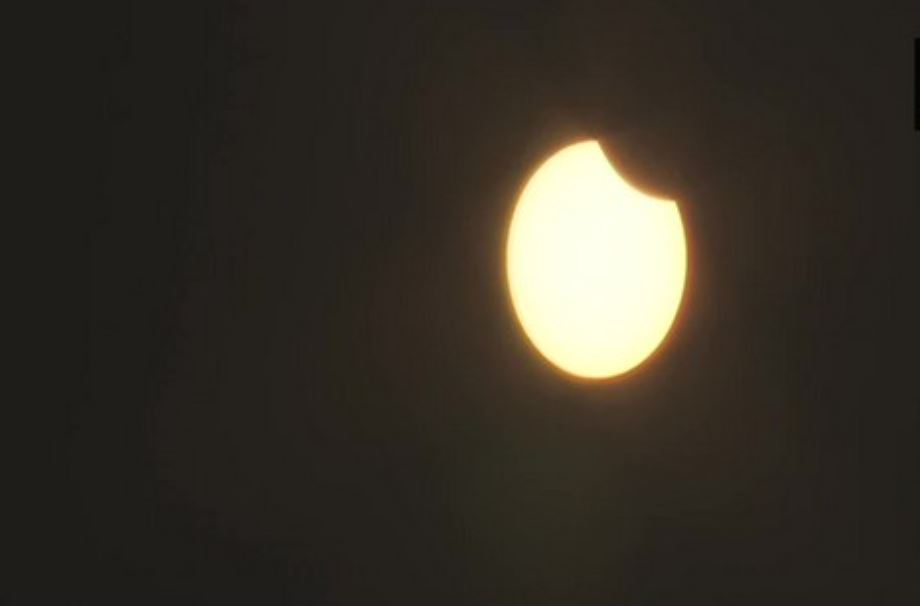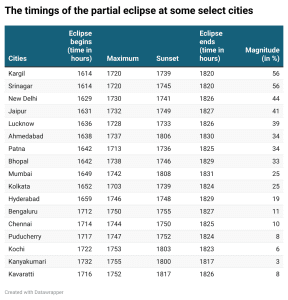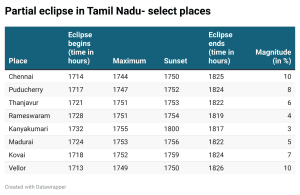
Solar eclipse 2022: All you want to know about partial eclipse on Oct 25

The solar eclipse occurring on October 25, 2022, is a celestial firework illuminating the festival of lights Diwali. Around sunset, the face of the sun would appear partially blocked for a brief moment, presenting a dazzling cosmic show.
Can I see it from my place?
 The partial eclipse will be visible all over India, except in Andaman and Nicobar Islands. However, the magnitude of the partial eclipse will vary from place to place. Up north in Kargil, at the moment of the maximum eclipse, 56.4 per cent of the face of the sun would be occluded by the moon. In comparison, way down in the south in Kanyakumari, just 2.8 per cent of the disc of the sun will be blocked during the maximum eclipse.The eclipse will commence when the disc of the moon begins to cover the face of the sun.
The partial eclipse will be visible all over India, except in Andaman and Nicobar Islands. However, the magnitude of the partial eclipse will vary from place to place. Up north in Kargil, at the moment of the maximum eclipse, 56.4 per cent of the face of the sun would be occluded by the moon. In comparison, way down in the south in Kanyakumari, just 2.8 per cent of the disc of the sun will be blocked during the maximum eclipse.The eclipse will commence when the disc of the moon begins to cover the face of the sun.
At Chennai, the first contact, sparśa, will start around 1714 hours, and the fourth contact, mokṣa, the ending of the eclipse, will take place around 1825 hours. Madyakāla or parvānta, when the maximum obstruction of the sun will take place, will be around 1744 hours. The sunset will occur at 1750 hours. Thus, when the maximum eclipse takes place, the sun will be almost on the western horizon. Even before the eclipse is completed, the sunset will take place.

How to see the eclipse
The partial eclipse occurs just about an hour before the local sunset, so low-hanging clouds and trees and buildings could obstruct the view. Hence you need to choose a location with an unhindered view of the western horizon.
The Public Outreach and Education Committee of the Astronomical Society of India (POEC-ASI), taking help from the Indian Institute of Astrophysics observatory at Hanle, Ladakh, is arranging a live stream of the eclipse from 1600 hrs to 1730 hrs. During the live stream, astronomers would give expert comments and answer the viewers’ questions. Many astronomy enthusiasts will also be doing live streaming.
Also read: Partial solar eclipse on Oct. 25, Chennai among cities that’ll witness it
Is the eclipse harmful?
Just like an umbrella temporarily obstructs the sun and provides shade, the moon’s shadow obstructs the view of the sun. Places on the surface of earth where the shadow of the moon falls experience solar eclipses. Rest of the world, the day is like any other day.
Therefore, it is not an event that affects sun’s internal process. The sun shines like another day and radiates in all directions. No mysterious rays are produced by it.
There is also no harm in eating and going out during the eclipse. Despite fake claims being circulated in social media, various studies have shown that cooked food does not get spoiled, specifically during an eclipse, nor going out and watching the eclipse is harmful. It is a natural celestial show, and to fear it is not human.
What about Rahu and Ketu
The cultural psyche in India is deeply permeated with the mythology of Rahu and Ketu. However, ancient Indian astronomers such as Aryabhata and Lallacharya scoffed at the idea of a heavenly demon devouring the sun and the moon as being the cause of the eclipses.
Āryabhaṭīyaṃ, a renowned treatise written by Aryabhata around 1,500 years ago, clearly states that the shadow of the moon falling on a location, results in a solar eclipse. When the moon enters the earth’s shadow, lunar eclipses take place.
Lallacharya, in his work Sishyadhivruddhida tantra, a handbook for students of astronomy written 1,300 years ago, unambiguously rejects Rahu-Ketu myths and Puranic claims. If the sun is swallowed by Rahu or Ketu, it should be invisible to everyone around the globe. Lallacharya says the falseness of the Puranic myth can be readily seen as the sun is visible in its full glory outside the eclipse path on the day of the eclipse. If the biting of the Rahu or Ketu causes the eclipse, then the sun should be in an eclipse worldwide.
For example, on October 25, 2022, the eclipse commences at 1614 hrs for a person at Kargil, while for a person in Chennai, the sun is still full and shining. The eclipse will be visible from Chennai only from 1714 hrs, nearly one hour later. Faith in the myths is, in fact, an affront to the scientific heritage of Indian culture rooted in the rational and logical works of Aryabhata and Lallacharya.
But Pachangas precisely predict eclipses.
There are mainly two types of panchāngam, vakya and drigganita (Drk), in South India. On the face of it, all the printed almanacs correctly give the October 25, 2022, time of the eclipse. But it is no great wonder. All the publishers of printed panchāngam source their data on eclipses from the Positional Astronomical Centre, Kolkatta. However, careful examination of other parameters published in the almanacs will readily reveal errors.
Tithi is a measure of angle sustained between the sun and moon. The duration for which moon maintains an angle of 1-12 degrees is called shukla paksha prathama (first waxing phase). From 12-24 degrees it is shukla paksha dwitiya, and so on. In the end, 348 to 360 degrees is amavasya.
In other words, when the amavasya ends, the angle subtended is 360 (=0). At this instant, earth, moon and sun are in the same plane.
We can readily see that during an eclipse, the maximum obstruction of the sun should occur at this instance.
According to vakya and Drigganita Pachanga, for Chennai the amavasya ends at 16:18 and 16:19, respectively. In contrast, the actual maximum eclipse transpires in 1744 hrs. The computation of traditional panchāngam deviates from the exact position of heavenly objects.
How to safely watch the eclipse
Any bright object is a threat to our eyes. Staring at bright light might cause harm from temporary discomfort to permanent retinal damage. That is why we are advised not to look at a flash of lightning. Eclipse or otherwise, staring at the bright sun is risky.
Do not use goggles, exposed x-ray films or smoked glass. They are not safe enough. One can use a solar filter made explicitly for watching the eclipse or project the image of the sun using a telescope or pinhole camera. Usually, astronomical institutions, planetariums, and science centres may make special arrangements to make solar filters available to the public. But it may not be possible everywhere.
Podcast: Key scientific takeaways from the solar eclipse
The Public Outreach and Education Committee (POEC) of the Astronomical Society of India suggests the following tips for viewing the eclipse:
- One can safely watch the sun if one can lay hands on Welder’s glass #13 or #14.
- Make a pinhole in a card sheet and hold it under the sun. Hold a white paper on the ground for the screen. The size and clarity of the image can be increased or decreased by adjusting the gap between the screen and the pinhole.
- Observe the shadow cast by a tree during an eclipse. Small gaps between the leaves also act like pinholes.
- One can use a fine mesh strainer. The sieves act like pinholes and create multiple beautiful images of the sun. You have an excellent pinhole projector by covering the colander with black paper and leaving only one hole uncovered.
- One can also use the ‘compact’ makeup kit mirror to make a sun projector. Cover the mirror with black paper and make a tiny hole in it. One can then reflect the sun image on a distant wall.(The writer is Scientist at Vigyan Prasar, Dept of Science and Technology)

